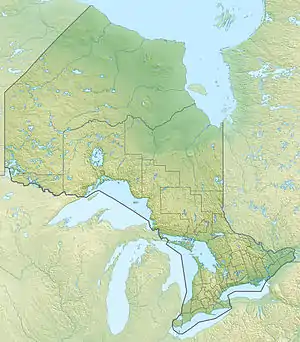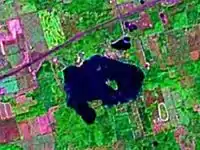Puslinch Lake
Puslinch Lake is a kettle lake located in Wellington County, Ontario, Canada. It is the largest kettle lake in Canada.[1][2] The lake is public however all areas to access it at this time are privately owned. However Ontario law states that there must be a public access to all Ontario lakes, so no they are not all private. The lake provides many recreational activities, including swimming, fishing, sailing, motor boating, and water skiing.[3] The Puslinch Lake - Irish Creek Wetland, a provincially significant area, is adjacent to the lake.[4]
| Puslinch Lake | |
|---|---|
 Island on Puslinch Lake | |
 Puslinch Lake | |
| Location | Ontario |
| Coordinates | 43°25′2.6″N 80°15′56.3″W |
| Type | Kettle |
| Catchment area | 9.725 km2 (3.755 sq mi) |
| Basin countries | Canada |
| Max. length | 2.012 km (1.250 mi) |
| Max. width | 0.805 km (0.500 mi) |
| Surface area | 1.56 km2 (0.60 sq mi) |
| Average depth | 1.4 m (4 ft 7 in) |
| Max. depth | 5.5 m (18 ft) |
| Water volume | 2,270,000 m3 (1,840 acre⋅ft) |
| Surface elevation | 303 m (994 ft) |
| Settlements | Puslinch, Ontario |

Hydrography
The lake is normally fed by surface runoff and underwater springs; there are no permanent inflow streams. Several ephemeral streams discharge into Mud Bay, however.[3] During high water conditions, the lake outflows into Puslinch Lake Creek, which is a part of the Grand River drainage basin. There is a channel connecting Puslinch Lake to Little Lake, located to the northeast. However, it is devoid of moving water, except for high water conditions.
Ecology
The lake is relatively shallow, most of it being less than 2 m in depth; the maximum depth is approximately 5.5 m.[3] The deepest area corresponds to only 0.4% of the entire lake. Because of that, and due to very limited inflow and outflow, the lake actively undergoes the processes of eutrophication, with associated algal bloom, low oxygen level, and periodic fish kills. While these processes are natural, their rate is increased by anthropogenic factors, since a large portion of the lake's shoreline was modified from its original state to allow residential development. Increasing thickness of organic sediments resulted in the necessity to dredge the lake. Settling ponds were constructed nearby; however, they were quickly deemed inadequate. A new approach was then implemented, involving moving the dredged material into porous bags, which allowed water to be released back into the lake. The remaining dried material is intended for sale as topsoil enrichment.[1]
Fish population
There are 16 species of fish present in the lake; some of them had been introduced. The lake supports a population of banded killifish, one of only a few known populations in the whole Grand River basin.[3]
References
| Wikimedia Commons has media related to Puslinch Lake, Ontario. |
- "Puslinch Lake Conservation Association" (PDF). Grand Actions. Grand River Conservation Authority. 9 (2): 2. April 2004. Archived from the original (PDF) on 2005-11-08. Retrieved 2008-03-31.
- "TOWNSHIP OF PUSLINCH EMERGENCY RESPONSE PLAN" (PDF). Township of Puslinch. 2004-06-16. Archived from the original (PDF) on 2011-07-06. Retrieved 2008-04-04.
- "Puslinch Lake Fish Habitat Assessment" (PDF). Ministry of Natural Resources (Ontario). September 2000. Retrieved 2008-04-04.
- "Natural Areas Report: IRISH CREEK/ PUSLINCH LAKE COMPLEX- WETLAND". Ministry of Natural Resources (Ontario). Archived from the original on August 20, 2009. Retrieved 2008-04-05.